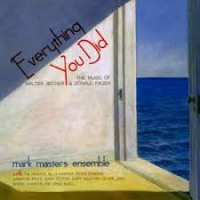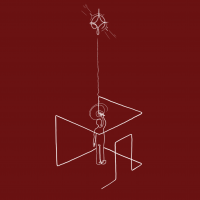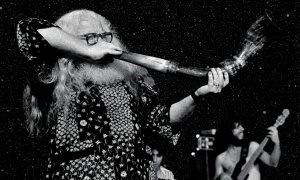Home » Jazz Articles » From the Inside Out » Vámanos – Let’s Go!
Vámanos – Let’s Go!
 Ҫiğdem Aslan
Ҫiğdem Aslan Mortissa
Asphalt Tango
2013
Ҫiğdem Aslan was born in the cultural crossroads of Istanbul. She moved to London, hoping to advance her onstage and classroom studies in various musical cultures; these studies include her Songs of Smyrna project, which celebrates rebetiko and sephardic music from Turkey, and joining the She'Koyokh Klezmer Ensemble and the Balkan group Dunav. Mortissa is her solo debut, composed of rebetiko and smyrniac songs (often called "the blues of the Agean") from the 1920s and '30s. "Most of the songs are in Greek," she explains, "and I didn't know the meaning when I first heard them. It was the music I could relate to. I felt close to them even if I didn't understand a word. Once I learned what they were about, it was even better. Most of them are love songs. They're familiar to me in the way they express things. The way a woman tells off her lover is similar to what I heard in Turkey."
Aslan recorded most of Mortissa with aces from North London's Greek and Turkish musical communities, including kanun (plucked dulcimer) master Nikolaos Baimpas; She'Koyokh backs up the rousing sing-along "Trava Vre Manga Kai Alani (Away With You, Manga)" and head-spinning clarinet jam "Ferece (Veil)."
"Kanarini (Canary)" sings a beautiful vocal and instrumental melody nourished by Middle Eastern percussion and strings. Like an impending storm, "To Dervisaki (Little Dervish)" grows more intense as violin, guitar and clarinet twist and bow in a dance with Aslam's vocal, so overwhelmingly mysterious that it sounds a bit dangerous.
"Nenni (Lullaby)"will stop you dead in your tracks. Aslan's unaccompanied vocal introduction is so perfect it's bewitching; beautiful, mysterious, vibrant, haunting, evocative—her voice is all these and more. Starkly illuminated by the backup of a solitary acoustic guitar, Aslan's vocal leaves in its wake the sense that "Nenni" is a vocal incantation passed down from voice to voice, from person to person, from generation to generation.
Mortissa is more than music: It is an open window into different cultures and histories. "What I'm doing is adding details and highlighting the similarities between the cultures," Aslan concludes. "Even something like a double bass in there makes it more modern. It's adding your personality. What I'm doing is putting my feelings into the songs, trying to reflect what they make me feel."
"It shows there are no cultural boundaries in music."
 Gerry Gibbs Thrasher Dream Trio
Gerry Gibbs Thrasher Dream Trio Gerry Gibbs Thrasher Dream Trio
Whaling City Sound
2013
Drummer, composer and bandleader Gerry Gibbs—son of renown vibes player and bandleader Terry Gibbs—grew up playing with musical legends from jazz traditionalists such as Clark Terry and James Moody, to Gary Bartz and Sam Rivers and other more adventurous conceptualists, to Parliament-Funkadelic and other artists who skirt the fringes in between. Gibbs' exceptionally dexterous work with pianists includes time spent in performance with bands led by Cedar Walton, Danilo Pérez, Kenny Kirkland and Brad Mehldau. Teamed here with two extraordinary artists, bassist Ron Carter and pianist Kenny Barron, their Thrasher Dream Trio collective name is self- explanatory.
Gerry Gibbs Thrasher Dream Trio presents a huge piece of work, 15 tracks spanning 74 minutes that would consume a double-vinyl album set. These include four new Gibbs originals: Musical portraits of Carter ("Here Comes Ron"), pianists McCoy Tyner ("When I Dream") and Don Pullen ("The Thrasher"), and Gibbs' wife ("The Woman on the Television Screen").
The considerable grasp and reach of this Dream Trio is immediately evident: Three of their first four tracks brilliantly juxtapose compositions by Thelonious Monk, Burt Bacharach and Hal David, and Johnny Mandel. Gibbs retains Carter's arrangement from a mid-70s recording of "Epistrophy" with Barron and Monk drummer Ben Riley; Barron's improvisation scales different, new heights in this familiar song while Carter and Gibbs seem to delight in trying to tie each other in rhythmic knots. Barron's piano beautifully sings "Promises, Promises," passing Bacharach's winsome melody lightly and expertly through his fingers while Carter and Gibbs weave a dance, almost a waltz, between them. Like "Epistrophy," it subsequently opens to spotlight Carter's strident walking bass, shaded by Gibbs' brushes on snare and Barron's distant, gentle chords. Barron's piano also colors Mandel's timeless "The Shadow of Your Smile" in warm, glowing reds and cool, soft blues.
Later in the set, Gibbs programs two adventurous Herbie Hancock tunes back to back. While Gibbs' playing (especially his cymbals and snare) often suggests a dance or a dancer, he arranges Hancock's frantic "The Eye of the Hurricane" to spotlight his torrid, bone-crunching breaks; the trio moves more somberly through darkness and shadow in "Tell Me a Bedtime Story."
Gerry Gibbs Thrasher Dream Trio is a trio album— not only a piano trio, but a genuine unified ensemble of three equal voices—of exceptional vision, dexterity and energy.
 Fareed Haque
Fareed Haque Out of Nowhere
Charleston Square
2013
Fareed Haque is quite clear about the impact of guitarist Pat Martino on his own playing: "He is my inspiration in jazz guitar. And if I have a mission, it's to blend the John McLaughlin world with the Pat Martino world. Every guitarist, every musician, is a synthesis of the history. So if you want to understand Pat Martino, you've got to listen to Jimmy Smith and Grant Green. And if you want to understand me, you've got to listen to John McLaughlin and Pat Martino."
Raised in Chicago by a Pakistani father and Chilean mother, Haque sang an indispensible voice in the late, lamented electric jam ensemble Garaj Mahal. He has since been voted Best World Music Guitarist by Guitar Player magazine and recorded and performed with Paquito D'Rivera, The Zawinul Syndicate and Sting. On Out of Nowhere, his Charleston Square label debut, the guitarist intersects two different ensembles: A trio with bassist George Mraz and drummer Billy Hart, and a larger ensemble with bassists John Tate and Doug Weiss, drummer Corey Healey, keyboardist Rob Clearfield and Salar Nader on tabla.
The trio sessions include the "Out of Nowhere" title track, where Haque's acoustic guitar shimmers with riffs that shine like quicksilver while Mraz and Hart heat up the rhythm pot to boiling beneath, altogether sounding like music made by Haque's inspiration, Martino. The trio closes this set with a meandering, abstract waltz, led by Mraz's bass, through "Lollipops & Roses," a Perry Como pop hit. Haque's parents had this Como album (By Request [RCA, 1962]) when he was a child, and he recalls it fondly: "It was great, if you like that kind of singing. You have to be in the right mood. If it's Christmas Eve with a fire going in the fireplace and you put on that record, it's the perfect mood."
Through the coolly meditative ten-minute opener "Waiting for Red," the quintet launches you deeply into Haque's music and his guitar sound, which seems to draw straight connecting lines between the boldness and brilliance of Martino and Pat Metheny. Haque switches to Moog synthesizer guitar to change the colors of John Coltrane's "Giant Steps." With Clearfield switching from piano to electric organ, Duke Ellington's "I Got It Bad and That Ain't Good" resurrects the classic Jimmy Smith / Wes Montgomery Verve sound, almost precisely three minutes but a big bedrock of groove music.
"I have recorded a lot of music," Haque concludes, "but at the end of the day I'm still from Chicago and I grew up playing jazz, blues and R&B on the Chicago scene. And this new album reflects that."
 Dave Liebman /Michael Stephans
Dave Liebman /Michael Stephans Lineage
Whaling City Sound
2013
In 2010, saxophonist Dave Liebman and drummer Michael Stephans began tossing around cover song ideas with guitarist Vic Juris, who was featured in the Liebman Group from 1991 through 2012. These conversations were soon joined by bassist Evan Gregor, keyboard player Bobby Avey and woodwinds player Matt Vashilishan. The resultant Lineage, subtitled Rock and Pop Classics Revisited, features songs by such cultural icons of the 1950s and '60s as Elvis Presley and The Beatles. Co-led by the saxophonist whose contributions to bands led by Miles Davis and Chick Corea helped expand the boundaries of modern jazz, the band on Lineage deconstructs rock, R&B and pop classics into...boundary-defying modern jazz.
Gutbucket guitar and tenor sax whip "Tequila" into a froth until the bottom drops completely out, leaving Liebman to freely swing without a net ("a quirky, angular and space funky re-take in 7/8 time," Stephans suggests). In their group improvisation on "Wipeout," the rhythm section keeps churning the original rhythm but Liebman stretches out the melody until it finally snaps. "Walk, Don't Run" dissolves into a hard-charging, piano-less saxophone trio where Liebman's free-fall stretches out the original tune way past the point of recognition. These three tunes use pop to construct jazz that hits as hard as rock.
Liebman and Stephans rework Stevie Wonder's "Visions" to float like a Return to Forever piece behind Liebman's soprano sax and Juris' acoustic guitar, which rings out in beautiful and clear tones ("Visions" was in the repertoire of the 1970s Dave Liebman Quintet that featured guitarist John Scofield).
Joni Mitchell's hopeful melody "Woodstock" morphs into an elegy for the legendary lost peace and love of this era, sung in Liebman's piercing, soaring saxophone. "I Only Have Eyes for You" sounds like a Thelonious Monk construction, especially its breathy piano and tenor sax introduction, which echoes Monk's work with Coleman Hawkins; produced to sound like there's worn vinyl record static in its background, "Love Me Tender" comprises a more dark and sinister piano/saxophone duet straight out of Bertolt Brecht.
"What we'd hoped to do was to 'put old wine in new bottles,' using the language of contemporary improvised music to re- clothe 'the oldies' in new harmonies and new rhythms, without destroying the integrity of the originals," Stephans explains. Mission accomplished.
 Trombone Shorty
Trombone Shorty Say That to Say This
Verve
2013
For his third Verve album, Troy Andrews, a/k/a Trombone Shorty and his band Orleans Avenue go back to school—more precisely, back to the slippery yet organic "old school" sound of R&B, soul and funk, thanks to contributions from composer, instrumentalist and co-producer Raphael Saadiq, formerly of the soul vocal group Tony!Toni!Toné! How does Shorty describe his new album? "Really funky, like James Brown mixed with The Meters and Neville Brothers, with what I do on top; and we have a bit of R&B from Raphael's side. All the guys in my band are big, big fans of his, so this is a real dream come true for us. And he's a fan of New Orleans brass band music, which I didn't know beforehand."
At 35 minutes (albeit across ten tracks), Say That to Say This is hardly Andrews' magnum opus. But his trombone solos consistently punch, ride and swing the beat hard and funky, and its best tunes seriously cook. "Get the Picture" dives headlong (not just knee deep) into slippery New Orleans funk rhythms, then turns to stomp and rock beneath Andrews' looped "I play the funk" vocal. The bright instrumental "Vieux Carre" bows then dances toward the Caribbean while the horn section dishes out sumptuous Crescent City soul stew.
Andrews and Saadiq build "Shortyville," a model replica of Andrews' musical birthplace, from the ground up. Its lush rhythm track deftly grooves like D'Angelo and Marvin Gaye jamming up and down Bourbon Street: Every instrument tucks into each other just right, overspread like thick sweet jam by Andrews' trombone solo and then set on fire by his blistering, funk-rock trumpet solo until he burns it out.
Say That also features the historic reunion of The Meters on "Be My Lady," from The Meters' eighth and final album (New Directions, 1977, Warner Bros.). Andrews telephoned each Meter and asked if they'd like to record it with him, and each replied that if the others would do it, he was in too. "After we were done, George Porter Jr. pulled me aside and said, 'Thank you. You have gotten us to do something that people have been trying to get us to do for 35 years,' and I was speechless," Andrews now recalls. "Because The Meters helped to create a sound that gave me a foundation for doing what I do. It was one of those magical moments in life for me because, in New Orleans, The Meters are like The Beatles."
 Various Artists
Various Artists Peru Maravilloso
Tiger's Milk
2013
Peru Maravilloso: Vintage Latin, Tropical and Cumbia demonstrates what's best about the digital media revolution: It resurrects 15 singles released by homegrown Peruvian labels across the 1960s and '70s, two of the most vibrant musical decades in the history of Peru (and just about everywhere else). Compiled by label managers Duncan Ballantyne, Andres Tapia and Martin Morales, it presents the lively South American styles of cumbia and guaracha and more electric sounds of chicha with strains of music from the Caribbean and Cuba leaking through like radio static.
As you'd expect, this robust and hearty musical stew of Peruvian, Cuban, African, Spanish and Andean influences bounces all over the map to radiate a quirky and colorful charm. Several Maravilloso tracks open windows into not just the music but the mood of a different culture and time: "Salsa 73" (by Chango y su Conjunto), dynamic if not perfect salsa spiced with tongue-tingling trumpet; and "La Cumbia Del Pacurro" (Juaneco y su Combo), "Para Chachita" (Los Zheros) and the psychedelic and percussive tropical chicha "Bailando en la Campiña" (Los Orientales), each built upon the dominant instrument, all around the world, of 1960s and '70s pop—the electric guitar.
"Piraña" (Pedro Miguel y sus Maracaibos) swirls together classic Cuban son montuno and tropical cumbia with trumpet so hot it snaps against the Afro-Cuban percussion and jangling electric guitar. Pop about the throes of mescaline, "Meshkalina" (Paco Zambrano y su Combo) is impossibly, irresistibly psychedelic '60s go-go in execution and production (with the chorus, "Let me die, meshkalina..."). Like The Adventures in Jazz Orchestra swimming through an epic tequila bender, "El Chacarero" (Los Gatos Blancos) pours out more psychedelic 60s instrumental guitar pop.
In "Sueño de Amor" (Zulu), Miguel Orbegozo's theatrical lead vocal rolls like waves in and out of the piano's strong groove, and when acoustic guitars and horns jump in for its closing verse, the sound clearly changes to reflect Sergio Mendes' Brasil '66, 1600 miles away in geography but close to its heart in spirit.
Each track was remastered from its original 7"/12" vinyl for Peru Maravilloso and is herewith presented for the first time since that single was originally issued in Peru.
Tracks and Personnel:
Mortissa:
Tracks: Aman Katerina Mou (Oh My Katerina); Vale Me Stin Agalia Sou (Take Me in Your Arms); To Dervisaki (Little Dervish); Bir Allah (One God); Pane Gia To Praso (Out for Leek); Trava Vre Manga Kai Alani (Away With You, Manga); Ferece (Veil); Nenni (Lullaby); Ҫakici; Sto Kafe Aman (At the Café Aman); Usakli Kiz (Girl from Uşak); Kanarini (Canary); S'agapo (I Love You).
Personnel: Nikos Angousis-Doitsidis: clarinet; Çigdem Aslan: vocals; Matt Bacon: guitar; Nikolaos Baimpas: baglama, kanun, mandola, mandolin, santouri, vocals; Makis Baklatzis: violin; H. Cahit Baylav: violin; Pavlos Carvalho: bouzouki; Philippos Demetriou: bells, finger cymbals, spoons; Odysseas Elia: bouzouki; Susi Evans: clarinet; Meg Hamilton: violin; Sevtap Isik: vocals; Vasilis Lemonias: cello; Paul Melas: guitar, vocals; Tahir Palali: baglama, davul, fretless guitar, oud, vocals; Vasilis Sarikis: finger cymbals; Guy Schalom: bendir; She'koyokh; Paul Tkachenko: double bass, mandolin.
Gerry Gibbs Thrasher Dream Trio:
Tracks: Epistrophy; Promises, Promises; When I Dream; The Shadow of Your Smile; The Woman on the TV Screen; The Eye of the Hurricane; Tell Me a Bedtime Story; A Feeling; Don't You Worry 'Bout a Thing; Sunshower; Here Comes Ron; Impressions; The Thrasher; Mr. Clean; The Theme.
Personnel: Gerry Gibbs: drums; Ron Carter: bass; Kenny Barron: piano.
Out of Nowhere:
Tracks: Waiting for Red; Tex Mex Jungle; Flood in Franklin Park; I Got It Bad; Giant Steps; Inner Urge; Out of Nowhere; Lollipops and Roses.
Personnel: Fareed Haque: electric guitar, acoustic guitar; George Mraz: bass; Billy Hart: drums; John Tate: bass; Doug Weiss: bass; Corey Healey: drums; Rob Clearfield: piano; Salar Nader: tabla.
Lineage: Rock and Pop Classics Revisited:
Tracks: Mr. Sandman; Eleanor Rigby; Visions; Tequila; I Only Have Eyes for You; Walk, Don't Run; Woodstock; Wipeout; Here, There and Everywhere; Love Me Tender.
Personnel: Bobby Avey: acoustic piano, electric piano, organ; Evan Gregor: electric bass, acoustic bass; Vic Juris: electric guitar, acoustic guitar; Dave Liebman: wooden flute, also saxophone, soprano saxophone; Michael Stephans: drums, percussion; Matt Vashlishan: clarinet, EWI, flute, alto saxophone, soprano saxophone.
Say That to Say This
Tracks: Say That to Say This; You and I (Outta This Place); Get the Picture; Vieux Carre; Be My Lady; Long Weekend; Fire and Brimstone; Sunrise; Dream On; Shortyville.
Personnel: Troy "Trombone Shorty" Andrews: trombone, congas, drums, trumpet, percussion, vocals; Michael Ballard: bass; Lemar Carter: drums; Charles Jones: organ; Pete Murano: guitars; Art Neville: keyboards, organ; Cyril Neville: vocals; Leo Nocentelli: guitar; Joey Peebles: drums, percussion; George Porter, Jr.: bass; Raphael Saadiq: bass, clavinet, guitar, keyboards, vocals; Charles Smith: percussion; Taura Stinson: vocals; Calvin Turner: bass; Zigaboo Modeliste: drums.
Peru Maravilloso: Vintage Latin, Tropical and Cumbia:
Tracks: Mambo de Machaguay; Salsa 73; La Cumbia Del Pacurro; Para Chachita; Piraña; Meshkalina; El Chacarero; Sueño de Amor; Bailando en la Campiña; Trinan las Golondrinas; Me Siento Felíz; Toro Mata; El Zambito Rumbero; La Gallina; Los Fabulosos en Onda.
Personnel: Lucho Neves y su Orchestra; Chango y su Conjunto; Juaneco y su Combo; Los Zheros; Pedro Miguel y sus Maracaibos; Paco Zambrano y su Combo; Los Gatos Blancos; Zulu; Los Orientales; John Benny y Los Ribereños; Los Ecos; Lucia de la Cruz; Manzanita y su Conjunto; Félix Martinez y sus Chavales; Aniceto y sus Fabulosos.
Tags
PREVIOUS / NEXT
Support All About Jazz
 All About Jazz has been a pillar of jazz since 1995, championing it as an art form and, more importantly, supporting the musicians who make it. Our enduring commitment has made "AAJ" one of the most culturally important websites of its kind, read by hundreds of thousands of fans, musicians and industry figures every month.
All About Jazz has been a pillar of jazz since 1995, championing it as an art form and, more importantly, supporting the musicians who make it. Our enduring commitment has made "AAJ" one of the most culturally important websites of its kind, read by hundreds of thousands of fans, musicians and industry figures every month.


























